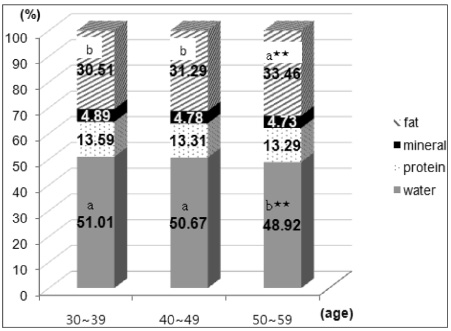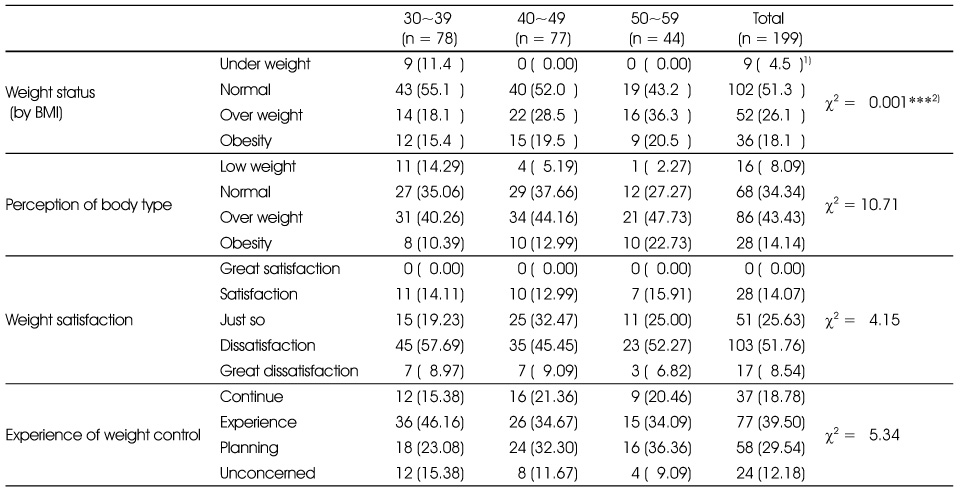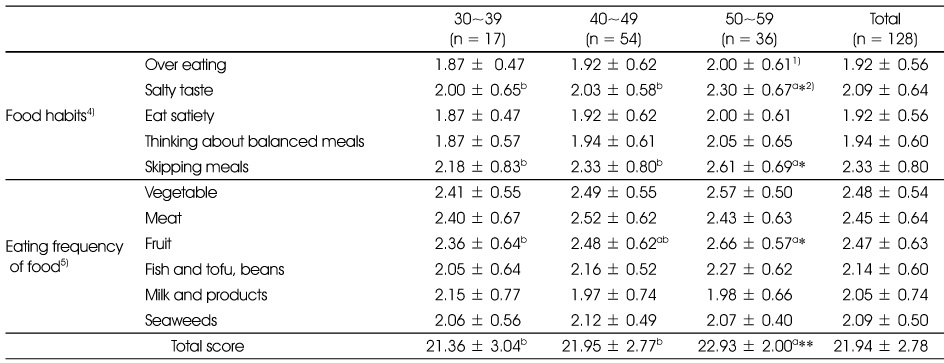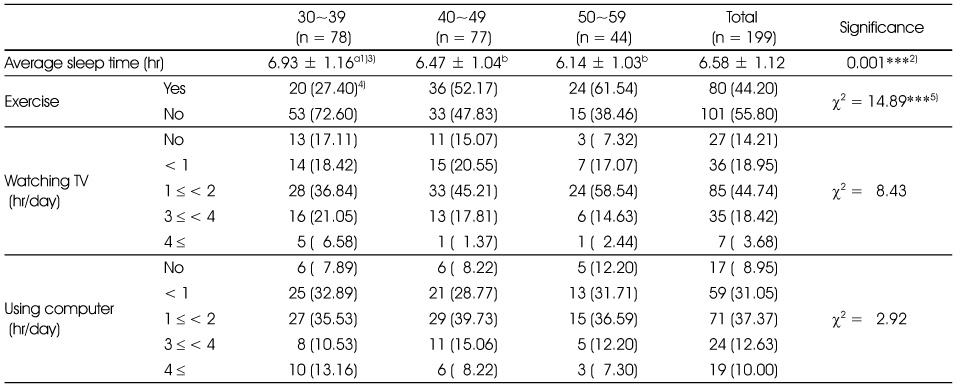References
1. Aloia JF, Vaswani A, Flaster E, Ma R. Relationship of body water compartments to age, race, and fat-free mass. J Lab Clin Med 1998. 132(6)483–490.
2. Biospace. User's manual (Inbody 230) 2008. Seoul: Biospace Co., Ltd;
3. Chang HS. A study on weight control behavior, eating habits and health-related life habits according to obesity degree by body fat percentage among middle-aged women in Gunsan city. Korean J Community Nutr 2010. 15(2)227–239.
4. Choi M, Kim MH. A study on bone mineral density, dietary habits and nutritional status of adult women in the three age groups. Korean J Food Cult 2007. 22(6)833–840.
5. Trémollieres FA, Pouilles JM, Ribot CA. Relative influence of age and menopause on total age and regional body composition changes in postmenopausal women. Am J Obstet Gynecol 1996. 175(6)1594–1600.
6. Gallagher JC, Riggs BL, Jerpbak CM, Arnaud CD. The effect of age on serum immunoreactive parathyroid hormone in normal and osteoporotic women. J Lab Clin Med 1980. 95(3)373–385.
7. Haroun D, Taylor SJC, Viner RM, Hayward RS, Darch TS, Eaton S, Cole TJ, Wells JCK. Validation of bioelectrical impedance analysis in adolescents across different ethnic groups. Obesity 2010. 181252–1259.
8. Hwang IC, Jo YN, Kim KK. The usefulness of waist to hip ratio estimated by bioelectric impedance analysis in diagnosing metabolic syndrome based on NCEP-ATP III guideline. Korean J Obes 2009. 18(3)79–86.
9. Jung IK. A study on the nutrient intakes and factors related to dietary behavior of women by age groups in Incheon. Korean J Community Nutr 2005. 10(1)46–58.
10. Koo JO, Park S. Analysis of BMI, body composition, weight control, dietary behaviors of adult women. Korean J Community Nutr 2011. 16(4)454–465.
11. Kim JH, Kim SH. A study on energy metabolism of Korean healthy women with age. Korean J Nutr 1989. 22(6)531–538.
12. Korean National Statistical Office. The statistics of life table 2010 2010. cited 2012 June 20. Available from
www.kosis.kr.
13. Korea Centers for Disease Control and Prevention & Korea Health Industry Development Institute. Korea national health & nutrition examination survey 2008. cited 2011 March 1. Available from
http://knhanes.cdc.go.kr/.
14. Korea Centers for Disease Control and Prevention & Korea Health Industry Development Institute. Korea national health & nutrition examination survey 2010. cited 2012 March 29. Available from
http://knhanes.cdc.go.kr/.
15. Ley CJ, Lees B, Stevenson JC. Sex-and menopause-associated changes in body-fat distribution. Am J Clin Nutr 1992. 55(5)950–954.
16. Lee HJ, Choi MR, Koo JO. A study of body image, weight control and dietary habits with different BMI in female high school students. Korean J Community Nutr 2005. 10(6)805–813.
17. Lee HS, Kwun IS, Kwon CS. Nutritional risks analysis based on the food intake frequency and health-related behaviors of the older residents (50 years and over) in Andong area (1). J Korean Soc Food Sci Nutr 2008. 37(8)998–1008.
18. Meeuwsen S, Horgan GW, Elia M. The relationship between BMI and percent body fat, measured by bioelectrical impedance, in a large adult sample is curvilinear and influenced by age and sex. Clin Nutr 2010. 29(5)560–566.
19. Moon HK, Kim EG. Comparing validity of using body mass index, waist to hip ratio, and waist circumference to cardiovascular risk factors of middle aged Koreans. J Korean Diet Assoc 2005. 11(3)365–374.
20. Ock SM, Ju SY, Choi WS, Park HM, Jung KI, Song CJ. Association of sleep hours with obesity in adult women. Korean J Obes 2008. 17(3)110–116.
21. Oh HJ, Cho DH, Chung HY, Han KO, Yoon HK, Han IK. Effects of obesity on BMD in pre & peri-menopausal Korean women. Korean J Obes 2000. 9(2)122–127.
22. Park JC, Kweon HJ, Oh YK, Do HJ, Oh SW, Lym YL, Choi JK, Joh HK, Cho DY. Association of the metabolic syndrome and bone mineral density in postmenopausal women. Korean J Fam Med 2010. 31(1)9–15.
23. Park SY. Nutritional status of anemic adolescent females, screening tools and the effect of nutrition education on improvement of iron status 2002. Graduate school of Catholic University; MS thesis.
24. Sakurai M, Takamura T, Miura K, Kaneko S, Nakagawa H. Middle-aged Japanese women are resistant to obesity-related metabolic abnormalities. Metabolism 2009. 58(4)456–459.
25. Sharpe JK, Byrneb NM, Stedmana TJ, Hillsb AP. Bioelectric impedance is a better indicator of obesity in men with schizophrenia than body mass index. Psychiatry Res 2008. 159(1-2)121–126.
26. Woo J, Kwok T, Lau E, Li M, Yu LM. Body composition in Chinese subjects: relationship with age and disease. Arch Gerontol Geriatr 1997. 26(1)23–32.
27. Woo SI, Cho SS. The influence of diet, body fat, menstrual function, and activity upon the bone density of female gymnasts. Korean J Nutr 1999. 32(1)50–63.







